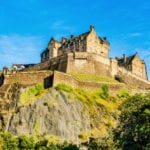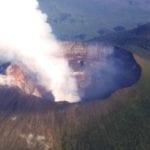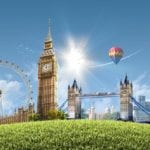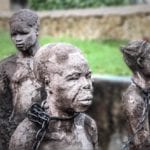 Mysteries
Mysteries  Mysteries
Mysteries  History
History 10 Surprising Stories About the Texas Rangers
 Humans
Humans 10 Philosophers Who Were Driven Mad by Their Own Theories
 Miscellaneous
Miscellaneous 10 Video-Game-Worthy Weapons and Armors from History
 Weird Stuff
Weird Stuff 10 Psychics Who Accurately Predicted Wartime Events
 The Arts
The Arts 10 Pieces of Art Inspired by a Broken Heart
 Health
Health 10 Science Fiction-Sounding New Medical Treatments
 History
History 10 Surprising Facts About the Father of Submarine Warfare
 Space
Space Ten Astonishing New Insights into Alien Worlds
 Weird Stuff
Weird Stuff 10 Bizarre Summer Solstice Rituals Still Practiced Today
 Mysteries
Mysteries Top 10 Haunting Facts About the Ghost Ship MV Alta
 History
History 10 Surprising Stories About the Texas Rangers
 Humans
Humans 10 Philosophers Who Were Driven Mad by Their Own Theories
Who's Behind Listverse?

Jamie Frater
Head Editor
Jamie founded Listverse due to an insatiable desire to share fascinating, obscure, and bizarre facts. He has been a guest speaker on numerous national radio and television stations and is a five time published author.
More About Us Miscellaneous
Miscellaneous 10 Video-Game-Worthy Weapons and Armors from History
 Weird Stuff
Weird Stuff 10 Psychics Who Accurately Predicted Wartime Events
 The Arts
The Arts 10 Pieces of Art Inspired by a Broken Heart
 Health
Health 10 Science Fiction-Sounding New Medical Treatments
 History
History 10 Surprising Facts About the Father of Submarine Warfare
 Space
Space Ten Astonishing New Insights into Alien Worlds
 Weird Stuff
Weird Stuff 10 Bizarre Summer Solstice Rituals Still Practiced Today
Top Common Misconceptions About Volcano Eruptions
Expert answers often come with jargon that can put you to sleep.
News stories help, but misinformation tends to creep in now and then. Journalists can’t be expected to sort through scientific minutiae during a crisis.
It’s up to us to figure out the truth. And as you read through this list, you might be surprised at what you only think you know!
Everyone loves watching volcanoes from a safe distance and sometimes even when they threaten us. That fiery power is fascinating.
We’re curious, too. How do eruptions happen? Is it safe to climb a volcano? What are supervolcanoes?
10 Utterly Spectacular Volcanoes In Space
10 Misconception: Molten rock powers eruptions
About 25-30 kilometers (15-20 miles) below our feet, there is intense heat and pressure. Some kinds of rock melt under these conditions, forming magma.[1]
That red-hot liquid rock has enough buoyancy to rise towards the surface through cracks in the overlying crust. It might not get there but if it does, there will be an eruption.
There’s a long way to go, though. Surely the weight of the overlying rock helps squeeze the magma along?
Nope. It’s running on gas — not fossil fuel, the gases dissolved in the molten rock. These include water vapor, carbon dioxide, and sulfur dioxide.
Gases bubble out of the magma as it gets higher, since the pressure is decreasing because there is less rock. You can safely get the same effect by opening a carbonated beverage bottle; the contents are under pressure, but carbon dioxide bubble appear when the seal is released.
But our magma conduit is still capped, so the gases have nowhere to go but out into the conduit. This speeds up the rising melt, and a chain reaction starts that can lead to an eruption, if the gases don’t run out and the magma doesn’t encounter a barrier of some sort that it can’t pass.[2]
If it does stop, then the magma will begin to cool, eventually freezing in place as a dike, sill, or pluton. Erosion sometimes uncovers these structures, revealing their beauty in places like Devil’s Tower in Wyoming.[3]
9 Misconception: Lava always erupts in flows
What’s missing here is the other half of the picture: lava can also explode onto the scene. We’re too busy running away or watching it in awe from a safe distance to realize that this is lava, too.
It all depends on the gases mentioned earlier, as well as the rising magma’s temperature and viscosity.
Temperature is a no-brainer. Molten rock reacts much like molasses does to temperature changes, slowing down as it cools off.
Viscosity isn’t complicated, either. Water has very low viscosity; asphalt is quite viscous.
Gases bubble away in water; asphalt won’t let them pass. This matters because rising magma is driven by gases.
It also contain silica, which tends to form long chains of molecules, increasing viscosity.[4]
The end result of all this geochemistry?
Low-silica magma lets most gas bubble away before the eruption, keeping just enough to power either a gorgeous Hawaiian-style lava flow, or if there’s a fair amount of silica present, something like the clip above.[5]
High-viscosity, high-silica magma, on the other hand, hangs onto more of its gases, building up more internal pressure. A similar pressure increase happens when you shake a champagne bottle.
Either way, the bubbles have nowhere to go until you uncork that bottle or the volcano’s rock gives way. Then, BOOM![6]
You now have a champagne-splattered sports team and a countryside covered in shattered lava, respectively.
8 Misconception: Volcanoes erupt smoke
Actually, the solid material in that impressive plume is rock and natural glass.
Don’t believe it? Ask Mexico’s Popocatepetl Volcano.[7]
During the terrible wildfire season this year in both hemispheres, we have seen plumes above major fires that certainly looked volcanic. But there is a big difference in their contents.[8]
Volcanic ash isn’t fluffy like bushfire ash. It’s all tiny bits of jagged stone and natural glass that get into your lungs and behind your contact lenses.
It’s heavy, too.
According to the US Geological Survey just 4 inches of it weighs 120-200 pounds per square yard. Even small accumulations of volcanic ash can overload and collapse a roof.
It will also do a number on your home electronics and cause power outages, since volcanic ash conducts electricity.[9][10]
Volcanic ash damages cars and other machinery. You will never see smoke affecting jet engines like this!
This is why there are Volcanic Ash Advisory Centers (VAAC) around the world,[11] constantly on the lookout for ash clouds in global flight lanes.
7 Misconception: Lava and pyroclastic flows are the deadliest hazard at volcanoes
Pyroclastic flows are indeed lethal. Lava flows, not so much.
Lava usually moves slowly enough that you can get out of its way.[12] There are exceptions, so don’t get cocky next time you visit an active volcano. Nevertheless, a study that looked at volcanic fatalities between 1500 AD and 2017 found that fewer than 700 people had been killed by lava.
Pyroclastic flows, which travel farther and much faster than lava, have a body count of almost 60,000 people. What could possibly match that?
Would you believe mud?[13]
What happens is that water mixes with volcanic ash, forming a heavy mixture like wet concrete that races down river drainages faster than people can run.
Volcanologists call these mudflows by their Indonesian name: lahar. You don’t want to get caught in one.
Lahars can also happen without an eruption. All that’s needed is water and loose ash. Heavy rainfall and tropical systems are notorious for causing secondary lahars.
In 2007 video above, the water came from a crater lake at New Zealand’s Mount Ruapehu:
All told, volcanic mudflows of various types have murdered almost 60,000 people over the last five centuries. They’re as hazardous as pyroclastic flows!
6 Misconception: Lakes don’t erupt
We all know that volcanic eruptions at sea are awesome.[14] Volcanoes near water can also cause tsunamis, like the one at Anak Krakatau in Indonesia in 2018 that killed four hundred people.[15]
Most of us, though, would never expect water to take the initiative and erupt on its own. But lake eruptions do happen, although there is usually a volcano lurking somewhere in the background.
That volcano’s gases seep through the lake bed into the water. Under the right circumstances (described below), they build up to the point where the lake explodes, unleashing all that gas in one deadly event.[16]
Lake Kivu, which is described in the video above, sits at the feet of Mount Nyiragongo in the Democratic Republic of the Congo.
Researchers are worried that future volcanic eruptions could start right under the city of Goma, located on the shores of Lake Kivu. That would be bad enough, but it likely would also set off a lake eruption, leading to a double tragedy.
But why would lava erupt in town, 14 kilometers (9 miles) from the volcano?[17]
5 Misconception: Eruptions start at the top of a volcano
Tell it to Mount St. Helens, which first exploded sideways in 1980 after a landslide removed rocks overlying the magma inside the mountain!
Active volcanoes do usually have at least one summit crater, but molten rock will exploit any zone of weakness it meets.
In 1977, for example, and again in 2002, Mount Nyiragongo’s famous lava lake drained out through large cracks in the surrounding rocky walls. The unexpected flank eruptions happened far down the volcano’s slopes, where there were villages, and many people died.
Volcanic fissures usually come in a network and can be quite extensive. One such system extends from Nyiragongo’s summit all the way to Goma, the provincial capital that sits on the shores of potentially deadly Lake Kivu.[18]
While no activity has been seen there in recorded history, it’s entirely possible that those fissures could host a future eruption.[19] And as we’ve seen, that could be a double catastrophe if it causes the lake to erupt, too.
On a happier note, beautiful Iceland is riddled with fissures – it sits on an area where two tectonic plates are slowly moving apart.[20]
Many fissure eruptions occur here. The last one, in 2014 at Bardarbunga Volcano, didn’t disrupt North Atlantic air traffic very much. It was also a spectacle.
In this video of drone footage, it sometimes looks as though the lava is coming from a crater. That’s actually a spatter rampart, where cooled globs from the lava fountains collect.[21]
4 Misconception: Exclusion zones are suggestions, not rules
Scientists go up there, why not us?
Because what you don’t know about a volcano can get you killed. This applies to experts, too.
In 1993, for example, a team of international volcanologists entered the crater of Colombia’s Galeras Volcano, which had been quiet for five months, to collect data on it for the Decade Volcano program.
They knew the risks and were ready to run whenever other scientists, who were monitoring the volcano’s real-time “vital signs” from a nearby observatory, spotted the least sign of impending trouble.[22]
Galeras gave no warning and exploded anyway, killing six volcanologists and three local residents who had come up to watch the fieldwork.[23][24]
Sudden changes like this are bound to happen when you have a mountain-sized pressure cooker sitting on a hot burner — even in “safe” places.[25][26]
Exclusion zones are common-sense rules, based on experience gained at the cost of human lives: almost seventy scientists and hundreds of thousands of other people.[27]
Even the tragedy at White Island/Whakaari Volcano in December 2019 spurred advances in volcanology.[28]
Sometimes a scientist takes chances, hoping to save many lives in the future.
But what about you? Are selfies, boasting rights, and the view worth entering a no-go zone and possibly ending up as just a data point on someone else’s research graph?
3 Misconception: All big eruptions are Plinian
For most of us, any explosive eruption is awesome. They’re Plinian, right, with the other type being pretty Hawaiian-style flows and fountains?
Actually, the Volcanic Explosivity Index (VEI) starts off with Hawaiian eruptions at VEI 0 and works its way up to VEI 8, a supereruption.
Along the way are a few intermediate grades and four different Plinian types.
Pictures are worth a thousand words, so let’s look at two explosive eruptions.
The clip above is Taal Volcano in January 2020, which certainly was a big and scary event.
It doesn’t yet have a VEI number, but Philippine volcanologists describe this eruption as steam related (“phreatomagmatic”).[29]
In terms of intensity, that’s not even close to Plinian.
While that certainly meets Pliny the Younger’s description of the Pompeii-destroying Mount Vesuvius eruption in 79 AD,[30] scientists can be fussy over details.
Some call this “classic Plinian”,[31] while others describe it as subplinian.[32]
The VEI scale gives geoscientists a common starting point for subtle disagreements like this. For example,[33]
• VEI 4 is “Pelean/Plinian”; think Eyjafjallajokul, the Icelandic volcano that messed up air traffic in 2010.
• VEI 5 is “Plinian”; Mount St. Helens, 1980.
• VEI 6 is “Plinian/Ultraplinian”; Pinatubo, 1991.
• VEI 7 is “Ultraplinian”; Tambora’s huge nineteenth-century eruption.[34]
Luckily, humanity hasn’t experienced a VEI 8 during recorded history. What would that be like?
2 Misconception: Supereruptions are like nuclear blasts
Which is easier: trying to absorb the fact that a supereruption blasts out at least 1,000 km3 (240 cu mi) of material[35] or just letting film makers and game designers imagine it for us?
Of course we go with simulations. Since the scale of such real-life events is beyond our experience, special effects artists often go nuclear.
Sometimes they try to stay close to science. Unfortunately, very little is definitely known about supereruptions, other than that at least two other giant calderas in the US besides Yellowstone have erupted during the last two million years, along with others in New Zealand, Indonesia, Japan, and South America.
Of these, Taupo in New Zealand hosted the world’s most recent supereruption about 23,000 years ago, while Indonesia’s Toba supereruption 74,000 years ago was the largest.
Currently, scientific explanations for how supereruptions happen include:
1. “Unzipping”: Multiple Plinian eruptions happen along giant ring fractures in the ground, emptying out the magma chamber below, which in turn collapses to form a caldera. This may have happened at California’s Long Valley Caldera.[36]
2. “Boiling over”: Some supervolcanoes, like Cerro Galan in Argentina, show no evidence of Plinian eruptions. Perhaps very dense clouds of crystalline magma poured out of the developing caldera here but were too heavy to rise very high (clip above).
We’ll never really know how supereruptions happen until we experience one. Let’s hope we survive it!
1 Misconception: Any supervolcano eruption means the end of the world
As little as we know about supereruptions, it’s still clear that the global consequences of one would be terrible.
But this doesn’t mean that we should all panic if the Yellowstone Volcano Observatory,[37] or its equivalent at any other supervolcano, ever posts a warning.
Small eruptions happen, too. In fact, experts note that Yellowstone’s most likely next round will either be a hydrothermal blast (a steam explosion large enough to toss rocks around) or a lava flow.[38]
Relatively small hydrothermal explosions are common at Yellowstone, happening every two or three years. Larger ones, those that form craters several hundred meters wide, occur every few thousand years.
And Yellowstone has had eighty known lava flows since its last VEI 8 some 630,000 years ago; the last one took place about 70,000 years ago. Such nonexplosive activity wouldn’t have much impact outside Yellowstone Park.[39][40]
Could scientists monitoring Yellowstone tell whether an impending eruption was going to be small or supersized? Yes, probably.
Because of the huge volume of magma on the move, a supereruption is likely have enormous precursors — those changes in seismicity, ground deformation, chemistry, and other measurements that signal upcoming changes in any volcano’s behavior.[41]
Even if a supereruption took place, it might not be an extinction-level event. Something too big to fit on the VEI scale, now, *that* would be a problem.
+ Misconception: Supervolcanoes are the biggest eruptions known
Don’t panic, but every twenty million years on average, the ground opens up and millions of cubic kilometers of molten rock either flow or explode across the land for 1-5 million years at a stretch.[42]
The word “millions” is why you shouldn’t panic.
The last time it happened was around 15 million years ago in the Pacific Northwest. Geologists call this large igneous province (LIP) the Columbia River Basalts because its eerie rocks now form the beautiful walls of the Columbia River Gorge.[43]
So we’ve got at least 5 million more years to go.
LIPs involve the sort of cutting-edge research that goes way beyond the scope of this article.
It’s fun to know, though, that geoscientists maintain a LIP of the Month web page.[44] That’s actually a pretty cool feature, even if (like most of us) you don’t have a PhD.
And it’s fascinating to think that volcanologists have found connections between some of these ancient events and a few modern volcanoes – relating Yellowstone to the Columbia River Basalts LIP, for instance, and Australia’s rare volcanic beauties, Heard and McDonald islands, to the mostly submerged Kerguelen Plateau LIP.[45][46]
Don’t worry. These places aren’t suddenly going to come to life again. They’re just the last flickering flames of a once terrifying fire upon the land.
Yellowstone still needs watching, but Heard Island is already wrapped in a thick blanket of snow and ice.
10 People Who Actually Fell Into A Volcano








